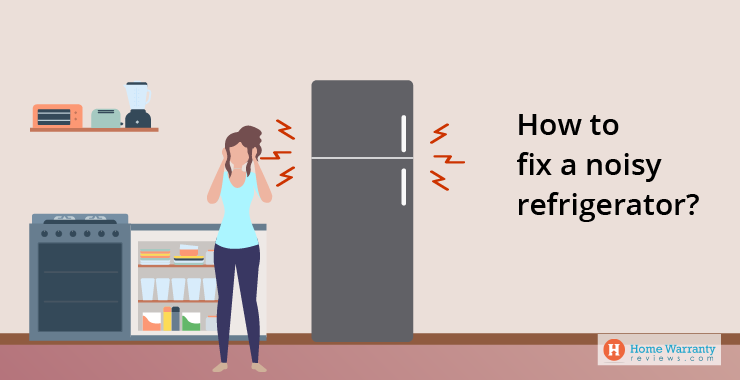How to fix a noisy refrigerator?
A refrigerator running in the background makes light humming noise, which often goes unnoticed. It is absolutely normal for refrigerators to make such a quiet hum. It’s only when the refrigerator makes a loud and unusual sound you have to investigate it. Refrigerators make noise due to various reasons. No matter what the reason is, a noisy refrigerator can surely get on your nerves. If you are looking at ways to identify the source of unpleasant sounds and tips on how to fix a noisy refrigerator, read through this article.

So, how do you fix your noisy refrigerator?
1. Fixing the clicking noise
Clicking noise can occur due to various reasons, including issues with condenser fan, start relay, or dirty condenser coils.
Check condenser fan
Although repairing a condenser fan requires expertise, you can still check the status of the condenser fan. The condenser fan cools down the refrigerant in the coils. If the condenser fan does not turn on, then the running compressor will overheat, resulting in clicking on & off sounds. The only possible solution here is to replace the condenser fan.
Test start relay
If you hear clicking sounds at regular intervals (every five minutes), it would possibly be the issue with the compressor’s start relay. The primary function of the start relay is to turn the compressor on & off. To check the start relay, unplug the refrigerator, remove the start relay from the socket and gently shake it. If you hear a rattling sound, then replace the start relay and fix it in the socket. On turning the refrigerator, you should not hear any clicking sound.
Clean condenser coil
The condenser coil, located either behind or beneath the refrigerator, are tubes in which refrigerant flows to emit heat. If the coils are dirty, they cannot depict heat efficiently, leading to clicking sounds. Clean the coils and observe if the clicking sound continues.
2. Fixing the buzzing noise
In most of the cases, the buzzing sound is absolutely normal. However, if the refrigerator isn’t cooling, then it signals a significant problem. Do not worry if your refrigerator is making buzzing sounds. There are many buzzing sounds that can be fixed by employing various techniques.
Balance the refrigerator
If you hear a buzzing sound near the bottom of the refrigerator, then it is most probably due to an imbalance. When the refrigerator runs, the slightly untouched leg vibrates or buzzes. Adjust the legs and check if the sound has stopped.
Replace the compressor
When the compressor becomes worn out, it begins to give out a buzzing sound. It might start to buzz and last for years or break down immediately. To check if the compressor is at fault, pull the refrigerator out from the wall & carefully hear if the lower end of the refrigerator is making a buzzing sound. If yes, then call the professionals and replace the compressor.
Put back the drip fan
Many a time, a dislocated drip pan can result in the buzzing sound. The drip pan is mounted on rubber foam to avoid vibration when the refrigerator is running. Sometimes the drip pan moves from its location and touches the radiator fin. Thus, when the refrigerator is running, the drip pan that is in contact with the radiator fin vibrates and creates a buzzing sound. To fix this, simply move the fan back into its place.
3. Fixing popping noise
Although harmless many a time, rattling sounds may sometimes indicate the need for repair. Some of the common reasons for rattling sounds are circulation fan, defrost timer motor, and compressor fan. The possible solutions for these problems are:
Replace circulation fan
One common reason for rattling sound is a failed circulation fan located behind an access panel. The circulation fan pushes air through the freezer and other refrigerator sections. Push the freezer light switch and check if the circulation fan is the culprit. If the issue is with the circulation fan, then the only option you have is to replace it.
Replace defrost timer motor
It is an integral component of the automatic defrost system in the freezer. It helps the refrigerator to determine the heater running time to melt the frost. When the motor operating defrost timer becomes malfunctioned, rattling sounds are heard. The logical way to fix this issue is to replace the defrost timer.
Clean condenser fan
Condenser fan blows the air to the condenser coil. Over a period, the fan accumulates dust. Clean the dirty fan blades to get rid of the annoying rattling noise.
4. Fixing thumping noise
Thumping noise is the refrigerator’s normal operational sound. If your refrigerator has an ice maker, then the thumping noise could be the sound of the waterline. However, if the refrigerator is producing more noise than ever, then there could be some serious issues that can be fixed.
Check for broken door bearing
Broken door bearing is one of the common reasons for thumping refrigerator noise. If the sound starts when the refrigerator door is opened more than halfway, it indicates a broken door bearing. Remove the refrigerator door to get access to the bearing and replace it.
Replace compressor spring
Compressor has 3 springs. When one of the springs break and the motor stops, the refrigerator makes a thumping noise. Although it doesn’t affect the overall refrigerator performance, fixing the broken spring can help you get rid of the annoying thumping noise.
Address damper assembly issues
Broken damper assembly can not only result in thumping noise but also freeze the food stored. The only solution is to replace the damper.
Now that you know how to fix a noisy refrigerator, fold your sleeves, and get going. If you require any assistance, consider contacting skilled technicians. Also, make sure to maintain your refrigerator regularly to avoid any expensive repairs and replacements.
RECENT ARTICLES
 Discover First American Home Warranty Locations and What You Need to Know About Their Cover.
Discover First American Home Warranty Locations and What You Need to Know About Their Cover.
 Reviews of Home Warranty Companies Show You How to Determine If Your Home Is Covered
Reviews of Home Warranty Companies Show You How to Determine If Your Home Is Covered




